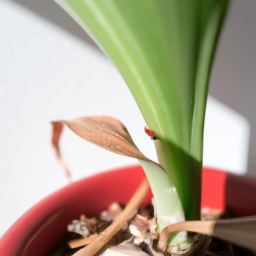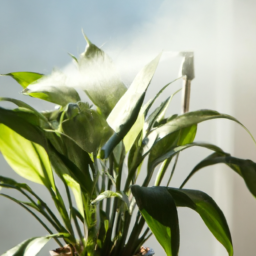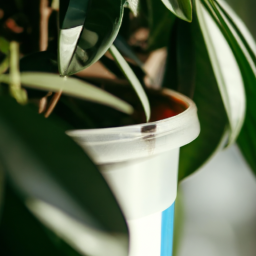
Hey there plant lovers! Have you ever wondered, “Can indoor plants get bugs?” Well, you’re in the right place because today we’re diving into the fascinating world of indoor plants and the pesky bugs that can sometimes invade their cozy homes. Whether you’re a seasoned plant parent or just starting your green journey, it’s essential to understand the potential risks and how to prevent or deal with insect infestations. So, let’s roll up our sleeves, grab a cup of tea, and explore the intriguing relationship between indoor plants and those tiny, unwanted visitors.
How to Identify and Treat Common Bugs on Indoor Plants
Indoor plants not only add beauty and freshness to our homes but also provide numerous health benefits. However, just like outdoor plants, indoor plants can also attract bugs. These pests can harm the plants and disrupt their growth if not identified and treated promptly. In this guide, we will discuss how to identify and treat common bugs on indoor plants, ensuring your green companions stay healthy and thriving.
Identifying Common Indoor Plant Bugs
Before jumping into treatments, it’s crucial to identify the type of bug infestation your indoor plants are facing. Here are some common bugs you may encounter:
1. Aphids: These tiny, pear-shaped insects are usually green or black and can be found in clusters on the undersides of leaves. They suck the sap from plants, causing leaves to curl and yellow.
2. Spider Mites: These minuscule pests are barely visible to the naked eye, but you may notice fine webbing on your plants. Spider mites typically feed on the undersides of leaves, causing yellow spots and eventual leaf drop.
3. Mealybugs: Mealybugs are small, soft-bodied insects covered in a white, waxy substance. They tend to congregate in leaf axils and leaf undersides, sucking sap and causing stunted growth.
4. Fungus Gnats: These tiny black flies are often seen buzzing around the soil of your indoor plants. Fungus gnats lay their eggs in moist soil, and the larvae feed on organic matter and plant roots, potentially leading to plant wilting.
5. Scale Insects: Scale insects appear as small, raised bumps on leaves and stems. They can be brown, black, or white and often cause yellowing and wilting of leaves.
Now that you can identify these common indoor plant bugs, let’s move on to the treatment strategies.
Treating Common Indoor Plant Bugs
1. Manual Removal: For a small infestation, manually removing bugs can be effective. Use a cotton swab dipped in rubbing alcohol to gently wipe off the bugs from the affected areas. Make sure to dispose of the bugs properly.
2. Insecticidal Soap: Insecticidal soaps are commercially available and can be sprayed on the affected plants. These soaps work by suffocating the bugs, but be cautious as they can also harm beneficial insects. Follow the instructions on the product carefully.
3. Neem Oil: Neem oil is a natural insecticide derived from the neem tree. Dilute it with water according to the instructions and spray it on the affected plants. Neem oil disrupts the pests’ hormonal balance, preventing them from feeding and reproducing.
4. Horticultural Oil: Horticultural oil is another effective option for controlling bugs on indoor plants. It works by smothering the pests and their eggs. Apply the oil spray thoroughly, covering all plant surfaces.
5. Biological Control: Introducing beneficial insects like ladybugs or predatory mites can help control pest populations. These insects feed on the pests, keeping their numbers in check. However, this method may not be suitable for all indoor environments.
6. Quarantine: If you notice bugs on one of your indoor plants, isolate it from the others to prevent the infestation from spreading. This will also make treatment easier and more targeted.
7. Maintain Plant Health: Healthy plants are more resistant to pests. Ensure your indoor plants receive proper light, water, and nutrition. Avoid overwatering, as it can create a favorable environment for bugs.
8. Regular Inspection: Regularly inspect your indoor plants for any signs of bugs. Early detection allows for prompt treatment and prevents the infestation from spreading to other plants.
9. Integrated Pest Management: Consider implementing an integrated pest management (IPM) approach. This involves combining various strategies, such as cultural practices, biological controls, and targeted pesticide use, to manage pests effectively while minimizing harm to the environment.
By following these treatment strategies and preventive measures, you can keep your indoor plants healthy and free from common bugs. Remember, patience and consistency are key when dealing with pest infestations. With proper care, your indoor plants will thrive and continue to bring beauty and joy to your home.

Effective Strategies for Preventing and Eliminating Bugs on Indoor Plants
Indoor plants not only add beauty and freshness to our homes but also provide numerous health benefits. However, just like outdoor plants, indoor plants can also attract bugs. These pesky insects can harm the health and growth of your beloved indoor plants if not dealt with promptly. In this article, we will explore effective strategies for preventing and eliminating bugs on indoor plants, ensuring that your green companions stay healthy and thriving.
Understanding the Types of Bugs that Infest Indoor Plants
Before we delve into the strategies, it is important to understand the common types of bugs that can infest indoor plants. By identifying the specific pest, you can choose the most appropriate method to eliminate them effectively. Here are some common bugs you may encounter:
1. Aphids: These tiny insects feed on the sap of plants, causing leaves to curl and distort. They reproduce rapidly, so it’s crucial to address an aphid infestation promptly.
2. Spider Mites: These minuscule pests are difficult to spot without magnification. They spin webs on the undersides of leaves and suck the plant’s juices, leading to yellowing and wilting.
3. Fungus Gnats: These small, dark flies lay their eggs in the soil. The larvae feed on plant roots, which can weaken the plant and make it susceptible to other diseases.
Preventing Bugs on Indoor Plants
Prevention is the key to keeping bugs away from your indoor plants. By implementing these strategies, you can create an environment that is less attractive to pests:
1. Inspect New Plants: Before bringing a new plant home, thoroughly inspect it for any signs of pests. Look under the leaves, along the stems, and even in the soil. Avoid purchasing plants with visible bug infestations.
2. Quarantine New Plants: Even if you don’t spot any bugs on a new plant, it’s always a good idea to quarantine it for a few weeks. Keeping it separate from your other plants will prevent any potential infestation from spreading.
3. Maintain Proper Plant Hygiene: Regularly clean your indoor plants by wiping their leaves with a damp cloth. This removes dust and debris, making it less likely for bugs to find a comfortable home on your plants.
4. Avoid Overwatering: Overwatering can create a damp environment that attracts pests like fungus gnats. Ensure that your plants receive adequate drainage and allow the soil to dry out slightly between waterings.
5. Provide Adequate Air Circulation: Bugs thrive in stagnant air. Keep your indoor plants in well-ventilated areas to discourage pests from settling in.
Eliminating Bugs on Indoor Plants
If bugs have already infested your indoor plants, it’s important to take immediate action to eliminate them. Here are effective strategies to combat bug infestations:
1. Manual Removal: For larger pests like aphids or caterpillars, you can manually remove them from your plants using gloved hands or tweezers. Drop them into a container of soapy water to ensure they won’t return.
2. Natural Remedies: Many natural remedies can help control bug populations. Neem oil, for example, is an effective insecticide that targets a wide range of pests and is safe for most plants. Mix it with water and spray it on affected plants.
3. Insecticidal Soaps: Insecticidal soaps are readily available in garden centers. These soaps work by suffocating the bugs and are safe to use on most indoor plants. Follow the instructions on the product label for best results.
4. Biological Control: Introducing beneficial insects like ladybugs or predatory mites can help control pest populations. These insects feed on the pests, keeping their numbers in check. However, be cautious when using this method, as some beneficial insects may also harm your plants.
5. Consult with Professionals: If the infestation persists despite your best efforts, it may be time to seek professional help. Pest control experts can provide targeted treatments to eliminate the bugs while ensuring the safety of your indoor plants.
By implementing these preventive measures and utilizing effective bug elimination strategies, you can maintain a healthy and bug-free environment for your indoor plants. Remember to regularly monitor your plants for any signs of infestation and address the issue promptly to keep your green companions thriving.

Common Signs and Symptoms of Bug Infestation in Indoor Plants
Indoor plants can bring life and beauty to any space, but just like outdoor plants, they can also fall victim to bug infestations. These tiny pests can wreak havoc on your beloved greenery if not detected and treated early. In this guide, we will explore the common signs and symptoms of bug infestation in indoor plants, helping you identify and address the issue promptly.
1. Visible Damage
One of the first signs of a bug infestation in indoor plants is visible damage to the leaves and stems. Keep an eye out for chewed or discolored leaves, as well as holes or tunnels on the foliage. Some bugs, like aphids and spider mites, also leave behind sticky residue called honeydew, which can attract ants and cause further damage to your plants.
If you notice wilting, stunted growth, or distorted leaves, it may be a sign of sucking pests such as mealybugs or scale insects. These pests feed on the sap of plants, causing them to weaken and become more susceptible to diseases.
Inspect your plants regularly, especially the undersides of leaves and along the stems, as bugs often hide in these areas. Use a magnifying glass if necessary to spot any tiny pests or eggs.
2. Presence of Webbing or Silk
Some indoor plants, like spider plants, are more prone to spider mite infestations. These tiny pests spin fine webs on the leaves, resembling spider silk. If you notice any webbing on your plants, it is a clear indication of a spider mite infestation.
Similarly, certain species of caterpillars and moth larvae create silk-like threads as they move around the plant. Keep an eye out for these silky trails, especially if you notice leaves being eaten or holes appearing.
Removing the affected leaves or gently wiping away the webbing can help control the infestation, but it’s important to address the underlying cause to prevent further spread.
3. Unusual Plant Behavior
Healthy indoor plants generally have consistent growth patterns and vibrant foliage. However, when bugs infest your plants, you may notice some unusual behaviors that indicate a problem.
For instance, if your once-thriving plant starts to lose leaves rapidly, it could be a sign of severe infestation. Bugs like thrips and whiteflies can cause significant leaf drop, leaving your plant looking sparse and unhealthy.
Another common symptom is the presence of yellowing or browning leaves. This can be caused by various pests, including fungus gnats and root mealybugs, which damage the roots and disrupt nutrient uptake.
Pay attention to any changes in your plant’s growth rate, flowering patterns, or overall appearance. These signs can help you detect a bug infestation early on and take appropriate action.
Remember, prevention is key to keeping your indoor plants bug-free. Regularly inspect your plants, maintain proper hygiene, and provide them with the right growing conditions. However, if you do notice signs of bug infestation, act promptly to prevent the problem from escalating.
Essential Points
Indoor plants are a popular way to bring nature into our homes and create a calming atmosphere. However, a common concern among plant owners is whether indoor plants can attract bugs. The short answer is yes, indoor plants can indeed get bugs, but it’s not something to panic about.
Just like outdoor plants, indoor plants are susceptible to pests such as aphids, spider mites, and fungus gnats. These pests can find their way into your home through open windows, doors, or even on new plants that you bring indoors. While it may be unsettling to discover bugs on your beloved houseplants, there are simple steps you can take to prevent and manage these unwanted guests. Regularly inspecting your plants for any signs of pests, such as yellowing leaves or tiny webs, is crucial. If you do spot bugs, don’t fret! There are various natural remedies and insecticides available that can help you eliminate the problem without harming your plants or your health. Remember to always follow the instructions provided and avoid overusing chemicals. Additionally, maintaining a clean and well-ventilated environment for your plants can go a long way in deterring bugs from infesting your indoor oasis.
Check Out These FAQs:
Q1: Can indoor plants get bugs?
A1: Yes, indoor plants can indeed get bugs. While we often think of bugs as being more prevalent outdoors, they can still find their way into our homes and onto our beloved indoor plants. Common pests that can affect indoor plants include aphids, spider mites, mealybugs, and fungus gnats.
Q2: How do bugs get into indoor plants?
A2: Bugs can enter indoor plants through various means. They may hitch a ride on new plants brought into your home, come in through open doors or windows, or even be carried in on your clothes or pets. Additionally, bugs can be present in the potting soil or on the plant itself when you purchase it.
Q3: What are the signs that my indoor plant has bugs?
A3: There are several signs that may indicate your indoor plant has bugs. Look out for yellowing or discolored leaves, tiny webs or silk-like threads, sticky residue on the leaves or surrounding surfaces, wilting or stunted growth, and the presence of small insects crawling on the plant or flying around it.
Q4: How can I get rid of bugs on my indoor plants?
A4: There are several methods to get rid of bugs on indoor plants. You can start by physically removing the pests by hand, using a gentle spray of water to dislodge them. For more stubborn infestations, consider using natural remedies like neem oil, insecticidal soap, or a mixture of water and dish soap. If the problem persists, you may need to resort to chemical insecticides, but use them cautiously and follow the instructions carefully.
Q5: How can I prevent bugs from infesting my indoor plants?
A5: To prevent bugs from infesting your indoor plants, it’s important to practice good plant care. Regularly inspect your plants for any signs of pests, and isolate any newly purchased plants for a few weeks to ensure they are bug-free. Keep your plants clean by removing dead leaves and debris, and avoid overwatering, as damp conditions can attract bugs. Additionally, you can introduce natural predators like ladybugs or use sticky traps to catch flying insects before they reach your plants.

James Wong is a renowned ethnobotanist, plant scientist, and local television presenter. With a passion for demystifying plant science, he is known for translating complex botanical concepts into practical advice for everyday plant enthusiasts. James’s expertise spans from traditional gardening to cutting-edge plant technologies, making his insights accessible and informative.


